
Since I finally managed to beat Zeromus (and I was kind of surprised when I did), I suppose I should say some more about Final Fantasy IV. This was the second game in the series to be released in North America, and I actually played FF6 before it. Looking back now that we have access to the games in between, it’s interesting to see how it compares. It’s pretty straightforward, certainly more so than 1 or 2. It has a story it wants to tell, which means going through the plot points one at a time. There’s some room for exploration, but most of the time it’s one thing leading to another. Even after you’re able to go anywhere on the surface of the world, you find out there are new places to explore underground and on the Moon, but can’t until you’ve accomplished certain tasks. Who’s in your party is also decided for you, and their abilities are the same throughout. FF1 lets you choose which classes your party members are, and you can upgrade them as well. 2 has a set party, with one rotating member, and how the heroes increase abilities depends on what they do in battle. 3 lets you switch between different jobs. In 4, only Cecil is with you the whole time, and he’s the only one who changes jobs, in a manner similar to that in 1.
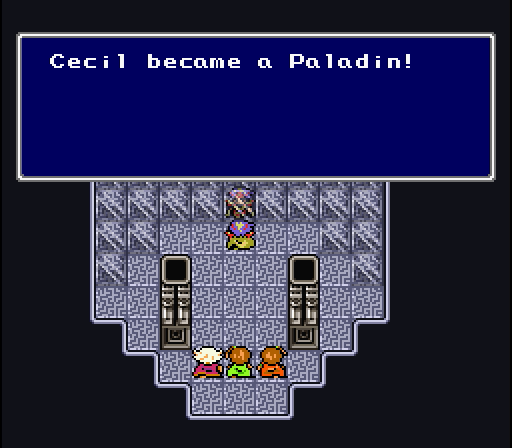
This is the first game where you can use a Paladin and an Engineer, but the other classes all appeared in previous games: Dark Knight, Dragoon, Summoner, White Mage, Black Mage, Sage, Bard, Monk, and Ninja. At any point in the game, you usually have a party that’s going to be able to handle the upcoming battles without too much trouble. 4 is also the first game in the series to really distinguish the characters’ personalities, although it does seem to gloss over certain elements that feel pretty significant, in order to move the plot along. You have the Elder of Mysidia basically saying, “You attacked our town, killed some residents, and stole our crystal, but you seem sorry, so go climb a mountain and all will be forgiven!”

And everyone is pretty much okay with Kain rejoining the party after betraying them on two separate occasions.
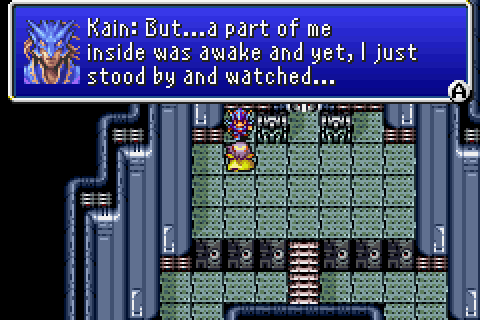
Maybe it was partially due to the translation, which was pretty sloppy on the Super Nintendo version, but it appears that key character motivations, particularly with Cecil and Kain, were kind of downplayed. There’s a mention of being a Dark Knight affecting Cecil’s well-being, but it doesn’t really come into the gameplay. Nor do I recall learning until somewhat later that Cecil was basically raised by King Baron, explaining why he’s so reluctant to disobey the monarch and why the people think he’s a good choice to be the next king. Kain’s jealousy of Cecil and love for Rosa also wasn’t as developed as it could have been, but maybe that’s partially because of Cecil being the viewpoint character. The game also loves to have characters appear to be dead and then reveal that they really aren’t, lessening the potential impact somewhat.
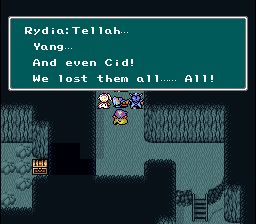
On the other hand, that’s mostly just with playable characters (only Tellah actually dies, and he’s still able to help you out against Zeromus), while pretty much everyone experiences other losses as well: Rydia’s mother and neighbors, Tellah’s daughter and Edward’s fiancee (the same person), and Edward’s and Edge’s parents; and Cecil and Kain were both orphaned before the events of the game. And a lot of them become kings at the end, although I don’t recall any preparation for Yang taking that position. The former King of Fabul just retires, rather than dying like most of the rest.
The plot of the game fits the general trend in this series to put in weird twists towards the end. That time loop in FF1 kind of comes out of nowhere, after all, and 3 has the whole thing with a separate world where time is frozen, or something like that.

Here, you find out that the hero and the villain are both sons of a magical being from space, that his species is originally from a planet between Mars and Jupiter that blew up, that they now live on the Moon, and that they introduced a lot of the more advanced technology on Earth. It’s several weird conspiracy theories combined into one.
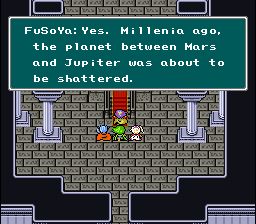
The story behind the story, as you eventually find out, is that a guy living on the Moon wants to destroy all life on Earth and take over the planet, and while he’s imprisoned underground, he can still use mind control on a half-Lunarian guy called Golbez. So he gets the idea to gather the eight crystals together, so he can summon a giant robot to destroy everything. Was that Zemus’ entire plan? Yeah, it’s a powerful robot, and Zemus doesn’t have any way of knowing that someone can fly inside it and destroy its core, but is that one mech actually going to kill everyone on the planet? I can only assume this is because he made the plan when humans were still rare and primitive, and he hadn’t really been keeping up with their development. But that does raise the question as to how much Zemus planned himself and how much he left to Golbez. After all, the plan as it worked out not only involved stealing the crystals, but also infiltrating and control of the main military power in the world. Speaking of which, maybe this was also the original translation or my own mind, but I initially got the impression that, when you confront Cagnazzo, he’d only just started impersonating the King, and wasn’t very good at it.

But now I think the implication is that he’d actually been in that role since before the beginning of the game, and he was able to fool Cecil, who’d known him since childhood, for a while before finally having to reveal his monster turtle form.

Maybe the Fiend deserves more credit than I gave him. On the other hand, the real King was presumably already beefing up the military and employing Dark Knights before the takeover. And after his death, he haunts the basement and is possessed by the Eidolon Odin, and I’m not entirely sure how that works.
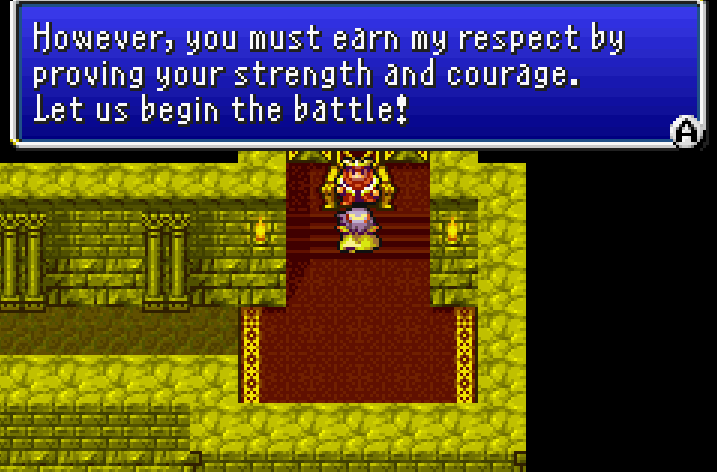
I do find it interesting that someone in Troia worries that the country will become a wasteland without the Crystal of Earth, which suggests that these gems have terraforming powers that seem way more impressive than the Giant of Babil, but we don’t really know how they work. It is a theme in these early FF games that the crystals are required to maintain the balance of the world.
Another thing I’ve seen about the story of FF4 is that your party is always one step behind, never able to stop Golbez from taking the crystals even when they are able to figure out his next move ahead of time. I was always a little annoyed at how you have no choice but to give Golbez the Earth Crystal when there’s no reason to trust him, but I suppose it is Cecil’s only chance of getting Rosa back alive.
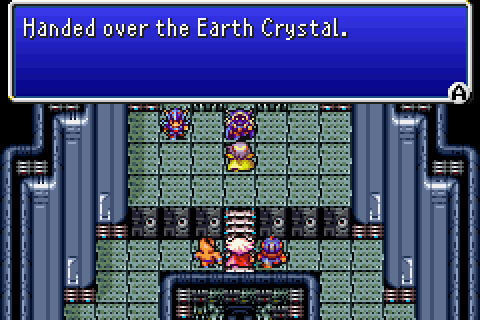
Then there’s the sequence where you defeat Golbez, but his disembodied arm is still able to grab the crystal. Maybe nobody could have actually prevented that, but it doesn’t seem entirely fair.

I didn’t experiment with any of the extra stuff the Advance version added in, specifically the ability to change party members after defeating the Giant of Babil and the new dungeon that opens on the Moon after beating Zeromus. By that point, I was anxious to move on to something new. I am wondering if I should revisit FF5, which I also stopped playing years ago when I couldn’t beat the final boss, but that might be a little more difficult to pick up again.

